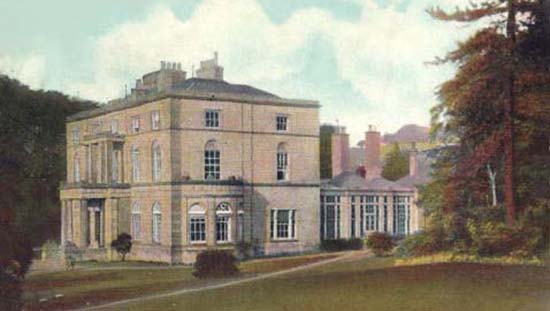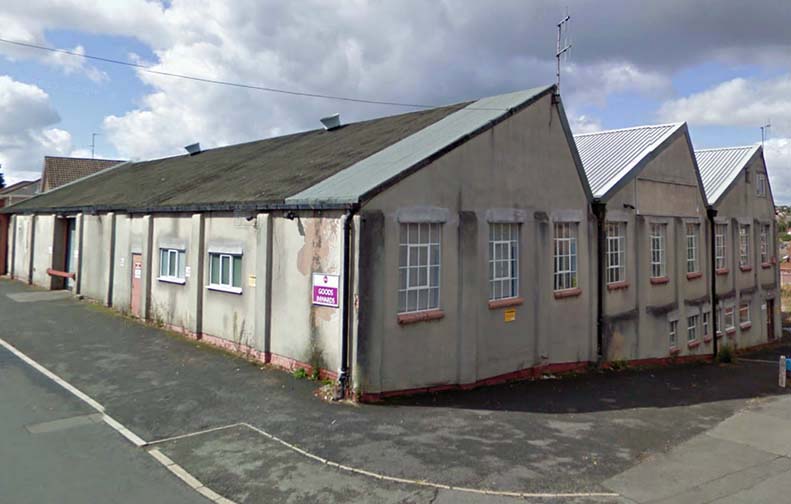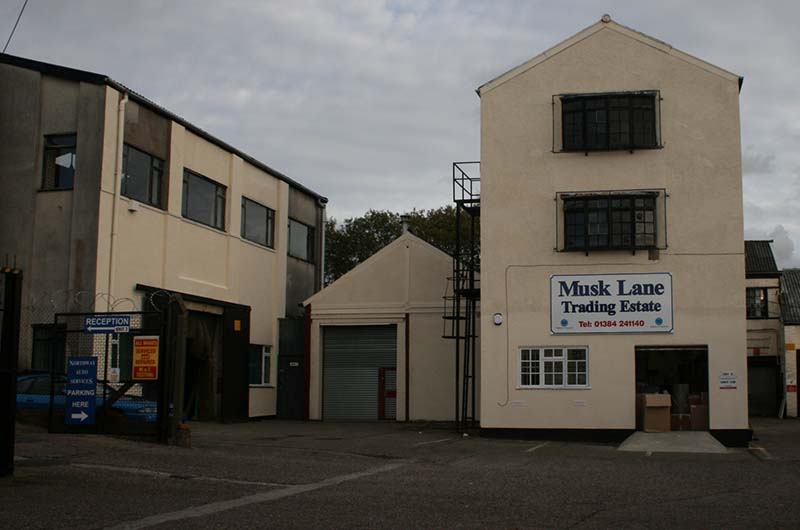
|

|
|||||
|
Landmarks ~
Churches ~
Pubs ~
Shops ~
Amenities ~
Dwellings ~
Events ~
Schools ~
Sports
Industrial ~ Transport ~ Folklore ~ Families
~ Gallery - Industrial ~
Mining
Ellowes Colliery and Dingle Pits
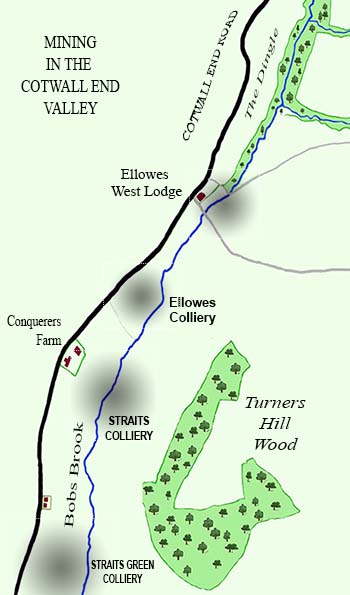
Ellowes Colliery was located just off Cotwall End Road
During the miners strike of 1926, unauthorized digging in the valley was taking place by unemployed miners
with 'bob holes' a few yards deep, when the Earl of Dudley, who owned the mineral rights heard about it,
his agent put a stop to it.
Benjamin Williams, a tenant of nearby Ruiton Farm, having gained permission from the Earl and paying royalties, took over the workings
and the Ellowes Colliery was established.
At first, a walk down slope with horse driven gin winding gear was employed to pull up the coal tubs. Later, two shafts, eighty yards deep were sunk to get at the seam of thick coal, an orthodox pithead with steam powered winding gear was used.
On a 1940 O/S map the colliery did have an engine house.
In 1945, Ellowes Colliery employed thirteen men, ten of these worked below ground. In 1944, the nearby land was taken over by the Ministry of Fuel and Power to meet the wartime demand and with the intention of opencast mining using heavy plant, however despite all the effort the expected output was not accomplished.
When the coal industry was Nationalised in 1947, the Coal Board took over the colliery from Benjamin Williams & Sons
and some further open-cast mining took place but it was again found unproductive, the colliery finally closed in 1951.
The workings have since been filled in and has now been reclaimed by nature.
Before the intense mining had begun, an Infectious Diseases Hospital existed
in the field where the shafts were dug, the hospital was short-lived
and was abandoned by the time of the mining operations.
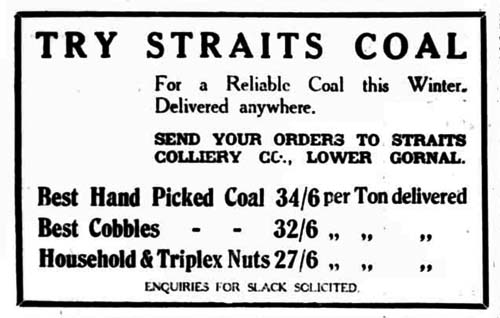 1931 newspaper advert.
1931 newspaper advert.
Bell or 'Bob' pits were often used for early mining operations in the valley,
for this reason Straits Brook was more often called Bobs Brook.
The coal was dug from around the bottom of a single vertical shaft forming a bell shape until there was a danger of collapse, and then a new shaft would be sunk nearby if need be. The coal was hauled up using a bucket and winding mechanism at the surface.
Muntin', was a local expression for picking coal from the pit banks and spoil heaps usually by women or children.
Just a little further up Cotwall End Valley, on land owned by Mr Nock of the Ellowes Hall,
another pit was established around 1933 by Chandler & Lee Limited, two shafts were sunk, one close
by to the old Ellowes West Lodge.
Thirteen men were employed below ground and a further seven above ground in 1938
London Fields Colliery Co. took over the pit and a further shafts were sunk further up the Dingle, this was a very
successful operation with large output whilst it lasted.
One of the shafts is now covered with a concrete pit cap and is quite noticeable if following the newly formed footpath. A refuse tip was established here to fill in around the pit mounds in the 1960s, changing the appearance of the area completely.
The following three drawings are by local artist Edward Morgan (1932-2010), the date of the drawings is
unknown but possibly sometime between 1950 and 1960,
the drawings show scenes in the vicinity of the Ellowes Colliery,
and are reproduced by kind permission of Barbara Morgan.
 "Gornal Ellowes Hall pit banks" by Edward Morgan. "Gornal Ellowes Hall pit banks" by Edward Morgan.
© estate of Edward Morgan.  "Lower Gornal open cast mining nr Ellowes Hall" by Edward Morgan "Lower Gornal open cast mining nr Ellowes Hall" by Edward Morgan
© estate of Edward Morgan.  "Old pit side Ellowes Hall Lower Gornal" by Edward Morgan. "Old pit side Ellowes Hall Lower Gornal" by Edward Morgan.
© estate of Edward Morgan. ~
Straits Colliery
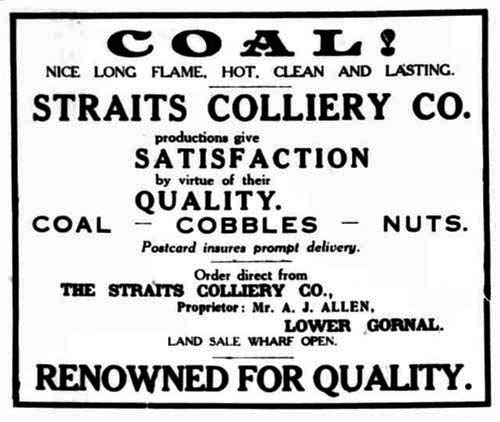 1930 newspaper advert.
1930 newspaper advert.
Frederick Allen, owner of the Conquerors Farm established this successful colliery around 1930.
The colliery was located near to Conquerors Farm in the lower part of Cotwall End Valley, here two shafts were sunk.
During this period John Baker, a venture endorsed by Mr Allen,
sunk a shaft right next to Conquerors Farm to get at the Flying Read ('flyin Red') coal,
but this proved unsuccessful.
In 1938, the colliery employed 38 workers.
In 1934, 'butty' collier Sam Ceney with the agreement with The
Earl of Dudley, sunk trial holes to prove fire clays gubbin ironstone and
coal beneath in the same area, and later mainly opencast mining was employed
to remove the clay which lay just above the coal seams.
Ceney from Dawlish House, Kingswinford, was already an established collier, with exploits around the Black Country during the 1920s.
The mining index shows 'Straits' colliery, owned by J. Clarke Jnr. as abandoned in 1923.
The Alley Colliery Co. Ltd., discontinued workings in December 1943.
~
Straits Green Colliery
1899: The London Gazette, 11 July.
This colliery was in production in the 1880s when it was owned by Thomas Glaze.
The partnership between Thomas Glaze, John Newey, and Mary Ann Newey trading as Thomas Glaze & Co., was wound up in 1899. Thomas Glaze Straits Colliery finished in 1907. William Gibbons, John Green and William Pugh were proprietors of Straits Green Colliery Limited in the 1920s, the partnership with Pugh was dissolved in 1927 and Gibbons and Green continued to run the pit. According to a newspaper report in 1932, the plot of 6 acres formerly the Straits Green Colliery site, was sold off.
1878: The following extract from the County Advertiser & Herald for Staffordshire and Worcestershire,
30 March, reports the start of the major coal getting in the dingle valley.
IMPORTANT FIND OF COAL AT LOWER GORNAL.The district of Lower Gornal is well known for the production of furnace coal, but strange to say the neighbourhood has for many years been considered by some of the most experienced mining engineers to be utterly fruitless in respect of the land containing any valuable minerals especially in the district of The Straits.The Straits is a pleasant village near Lower Gornal, where about thirty year ago two enterprising colliery proprietors Messrs. Osbourne and Cox, sunk a pit shaft for the purpose of ascertaining if there was any coal. On the one side of the Permian measures and on the other were the Silurian measures and after sinking a great depth -- which entailed a heavy expenditure of money - the proprietors found that their speculation was a bad one, there being no indication of coal. As may be imagined, the proprieties were thoroughly disheartened, and eventually disposed of their property -- which consisted of about five or six acres of land -- for farming purpose -- Since the above trial was made, the Silurian measures on the east side have been considered very doubtful as to their containing any valuable minerals, but as the further search for coal was likely to be attended with great risk, no further steps were taken for a period of about thirty years. A short time ago, however, the piece of land near the ground where a shaft was sunk by Messrs. Osborne and Cox at The Straits was purchased by Mr. Thomas Glaze, of Corbyn's Hall, and, being desirous of making a search for coal, he decided to sink a pit shaft near Turner's Hill. The task was commenced under very trying circumstances, but on sinking to a depth of 22 yards Mr. Glaze was gratified to find the brooch coal, and at a depth of 60 yards succeeded in discovering the ten-yard thick coal, of very good quality, notwithstanding the site of the pit shaft being near the Silurian measures. This find is considered to be one of great commercial importance, inasmuch as the measures of coal and ironstone are declared by competent engineers to extend to the Earl of Dudley's well known Himley Collieries. This will add about 200 acres of coal and ironstone to his lordship's estate, which, at the recognised scale of 40,000 tons to the acre, will amount to 8,000,000 tons. There will also be a similar area of whitestone, which will be of great value, it being in conjunction with the ironstone -- the minerals used for the best brands of iron manufactured in South Staffordshire. The collieries will be erected in close proximity to the furnaces in the district, and also those close to the neighbourhood of Kingswinford, Dudley, and Stourbridge. It is stated on good authority that the Earl of Dudley's agent contemplates putting down shortly similar plant and machinery to that at The Lye Cross Pits at Rowley, in order that the collieries may be worked to the best advantage. In the event of a revival of trade it is estimated that employment will be provided for about one thousand persons. --a circumstance which will add to the prosperity of the district --
At the peak of production around the end of the Nineteenth Century,
a tramway was built employing horse drawn coal tubs, the tramway ran
south from the mine and under the Himley Road near Askew Bridge and terminated
at the Earl's mineral line just beyond,
however by 1920, the tramway had disappeared.
1880: Newspaper report, 6 August.
1886: The Aberystwith Observer, 9th January.
1932: Dudley Chronicle, 10th November.
~
|
|

